学术论文写作技巧
学术研究论文撰写技巧
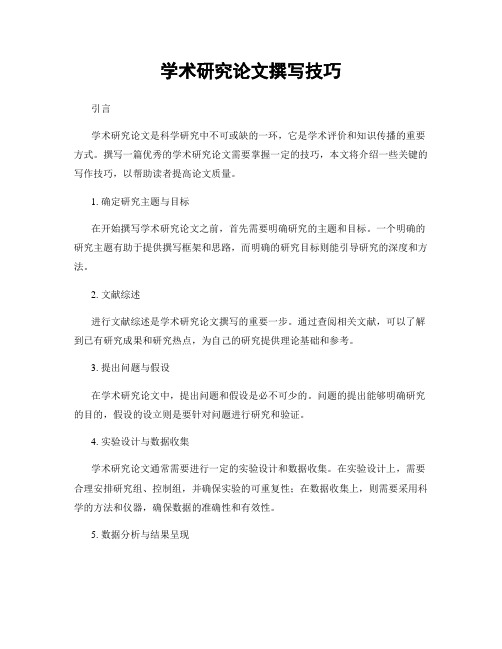
学术研究论文撰写技巧引言学术研究论文是科学研究中不可或缺的一环,它是学术评价和知识传播的重要方式。
撰写一篇优秀的学术研究论文需要掌握一定的技巧,本文将介绍一些关键的写作技巧,以帮助读者提高论文质量。
1. 确定研究主题与目标在开始撰写学术研究论文之前,首先需要明确研究的主题和目标。
一个明确的研究主题有助于提供撰写框架和思路,而明确的研究目标则能引导研究的深度和方法。
2. 文献综述进行文献综述是学术研究论文撰写的重要一步。
通过查阅相关文献,可以了解到已有研究成果和研究热点,为自己的研究提供理论基础和参考。
3. 提出问题与假设在学术研究论文中,提出问题和假设是必不可少的。
问题的提出能够明确研究的目的,假设的设立则是要针对问题进行研究和验证。
4. 实验设计与数据收集学术研究论文通常需要进行一定的实验设计和数据收集。
在实验设计上,需要合理安排研究组、控制组,并确保实验的可重复性;在数据收集上,则需要采用科学的方法和仪器,确保数据的准确性和有效性。
5. 数据分析与结果呈现数据分析是学术研究论文的重要环节,通过对实验数据的统计和分析,可以验证研究的假设。
在结果呈现上,可以采用图表和数据表格的形式,简明扼要地展示结果,提高论文可读性。
6. 讨论与解释结果在学术研究论文中,讨论和解释结果是至关重要的一部分。
通过分析实验结果,可以发现其中的规律和规律,进一步深入探讨和解释研究问题,对研究领域的具体问题提出自己的观点和见解。
7. 撰写论文结构学术研究论文的结构要清晰合理,包括介绍、方法、结果、讨论和结论等几个部分。
每个部分都应该有足够的内容,以明确表达作者的研究思路和发现。
8. 注意逻辑与连贯性学术研究论文应当遵循一定的逻辑顺序,确保论文的连贯性和可读性。
在撰写过程中,需要注意段落与段落之间的过渡,合理安排论文的层次和章节,使得整篇论文结构严谨。
9. 注意语言风格与准确性学术研究论文应该采用正式的语言风格,避免使用口语化和生活化的表达方式。
学术研究论文写作技巧模板

学术研究论文写作技巧模板在学术领域,撰写一篇优秀的研究论文是每位研究人员都要面对的挑战。
本文将介绍一些撰写学术研究论文的技巧,帮助您更好地组织和表达研究成果。
一、引言部分学术研究论文的引言部分起到承上启下的作用,用于引出研究问题、解释研究目的和意义。
在引言部分,您可以按照以下结构组织内容:1. 研究背景和意义:简要介绍研究背景,引出研究问题,并说明研究的重要性和意义。
2. 相关研究综述:回顾与您的研究相关的前人研究成果和存在的问题,并指出本研究的创新点和差异之处。
3. 研究目的和研究问题:明确您的研究目的,并列举研究问题,以引出您的研究方法和研究内容。
二、研究方法部分在研究方法部分,您需要详细描述您所采用的研究方法和实验设计。
在这一部分,您可以按照以下格式组织内容:1. 研究设计:说明您的研究是实验研究、调查研究还是文献综述等,并解释您设计该研究的理由和依据。
2. 研究对象和样本:描述您研究的对象或对象群体,并解释您选择该对象的理由。
同时,说明样本的选择过程和标准。
3. 数据收集方法:介绍您采集数据的具体方法和工具,例如问卷调查、实验记录等。
4. 数据分析方法:展示您使用的数据分析方法,例如统计分析、回归分析等。
三、研究结果部分研究结果部分是论文的核心,您需要清晰地陈述您的研究结果,并用适当的表格、图表或图像来展示数据。
遵循以下结构可以使您的研究结果更加清晰明了:1. 结果总览:简要总结您的研究结果,给读者一个整体认识。
2. 文字描述结果:通过文字描述详细介绍您的研究结果,可以使用段落或编号方式。
3. 图表展示结果:用适当的图表或图像展示您的数据结果,注意图表的清晰度和易读性。
四、讨论与结论部分讨论与结论部分是对研究结果进行解读和总结的部分,也是给读者留下深刻印象的关键部分。
总结您的讨论与结论部分时,考虑以下内容:1. 结果解读:对研究结果进行解读,将其与前人研究成果进行对比和分析。
2. 研究局限和不足:指出研究中存在的局限和不足之处,避免过于绝对的表述。
学术论文写作的四大的方法

学术论文写作的四大的方法1.模仿法研究生在学术论文写作中遇到最大的困难就是,不知如何选题,不知如何搜集和运用资料,不知如何搭建论文框架结构,也不知写些什么内容,总之不知如何下手。
因此,此方法特别适用于初学论文写作者。
在实践中,有研究生反映,很多学术大家的论文,艰深难懂,看后产生了畏惧写作的心理,有的反映,看了一线教师教研论文,觉得简单,但又不会写,因为缺乏实践经验;还有的反映,论文创新太难,误认为创新就是“全新”,由此不敢写作。
其实,就创新而言,不等于“全新”。
创新的要点很多,包括题目的创新、结构的创新、思路的创新、观点的创新、参考资料的创新以及研究方法的创新等诸多方面,对于一篇文章具备的创新点越多,其创新性也就越强。
我们研究生在写作时,不要盲目追求“全新”,先低标准要求自己,找一篇同类或类似的文章(和自己研究水平相当或略高于)做参照。
可以在行文结构、语言风格等方面进行模仿,而后逐步修改,走模仿到创新之路。
2.作业法目前,在读研究生的专业基础课、专业方向课方面的作业,一般都是以学术论文的形式出现的。
然而,很多研究生在做作业时,有一种敷衍、应付的心理,东拼西凑,既糊弄了任课教师,同时也欺骗了自己。
笔者认为,研究生要认真对待每一份课程作业,认真选题,搜集资料,按照发表的水平来撰写论文。
这样的作业,如果比较成熟,可以随时按照某刊物的要求修改调整并投稿;如果不成熟,则实行冷处理的方法,停放一段时间,等待有新的思考、新的资料、新的观点时再及时补充到该作业(论文)之中,并逐步达到发表水平。
3.切块法作为导师,要积极鼓励研究生参加调研课题和书稿的撰写工作。
一般而言,一个课题或一部书稿,都有明确的结题或完稿的时间限定。
这种紧迫性就要求参与者必须潜心读书,严格要求自己,认真撰写出高质量的研究成果来。
不论是结项或是著作出版,都要经过有关部门鉴定和认可,这无形中给参与者增加了压力,也增加了科研的动力。
之所以提倡研究生参与课题或书稿的编写,原因之一就是“切块法”得到广泛的运用。
提高学术论文写作质量的十个技巧

提高学术论文写作质量的十个技巧学术论文写作是每个研究人员、学生的重要任务之一。
无论是在本科阶段还是在研究生阶段,撰写优质的学术论文都是提高自己在学术界的声誉和贡献的关键。
然而,许多人在写作过程中常常遇到困难,包括展开思路、组织论证、语言表达等方面。
为此,本文将提供十个技巧,帮助你提高学术论文写作质量。
1. 深入研究主题:在撰写学术论文之前,对主题进行全面系统的研究是至关重要的。
阅读相关文献、查找权威期刊等可以帮助你熟悉该领域的前沿研究,掌握最新的理论和实践。
2. 确定清晰的论点:在写作过程中,明确的论点是至关重要的。
论文的整体结构和核心内容应围绕论点展开,确保论文的逻辑性和连贯性。
3. 制定详细的提纲:在开始写作之前,制定一个详细的提纲有助于组织思路和论证。
提纲可以明确每个段落的内容,保证论文的逻辑和结构性。
4. 使用明确的语言和术语:学术论文需要使用准确、明确的语言和术语来表达论点和观点。
避免使用模糊、含糊不清的措辞,确保读者能够理解你的意思。
5. 注意段落结构:每个段落应只包含一个主题,并且应按照逻辑次序组织。
段落之间的过渡要流畅,确保读者能够轻松地跟随论文的思路。
6. 引用相关文献:在学术论文中,引用其他研究的观点和证据是必不可少的。
引用应遵循学术规范,包括正确的引文格式和正确的引用用语。
7. 积极参与同行评审:在撰写学术论文的过程中,积极参与同行评审可以帮助你发现论文中的不足之处,并改进你的写作技巧。
8. 确保语法和拼写正确:语法和拼写错误对于学术论文来说是不可接受的。
在完成论文后,务必进行仔细的校对,确保文章没有语法错误和拼写错误。
9. 适当使用图表和数据:图表、表格和数据可以帮助读者更好地理解你的研究结果。
在使用图表和数据时,要保证其准确性和清晰度,并确保它们与论文的主题和内容相一致。
10. 反复编辑和修改:最后一个技巧是反复编辑和修改你的学术论文。
反复修改有助于提高论文的流畅性和连贯性,同时还能排除可能出现的错误和不完善之处。
论文写作技巧范文

论文写作技巧范文1.确定论文主题:选择一个能够激发兴趣且有研究价值的主题是非常重要的。
这样才能保证论文写作的动力和热情,同时也容易找到更多的文献和资料来支持自己的研究。
2.进行充分的文献调研:在开始论文写作之前,要进行充分的文献调研。
这样可以了解到已有的研究成果和学术观点,帮助你确定自己的研究角度和论文结构。
3.制定合理的论文结构:在开始写作之前,制定一个合理的论文结构是非常重要的。
一般来说,论文应包含引言、文献综述、方法、结果和讨论等部分。
合理的结构可以使整篇论文更加清晰和易读。
4.语言表达要准确:论文是学术性的写作,因此语言表达要准确。
避免使用口语化的表达和模糊的词汇,要尽量用准确的学术术语和句式来表达自己的观点。
5.展开论证过程:论文不仅要描述问题,还要展开论证过程。
通过提供充足的证据、数据和引用来支持自己的观点,使论文更有说服力。
6.注意论文的逻辑结构:论文应该有清晰的逻辑结构,每一段落和章节之间应该有明确的衔接和过渡。
这样读者在阅读论文时能够更容易理解你的观点。
7.控制论文的篇幅:论文一般都有字数限制,要控制好论文的篇幅。
避免出现内容重复或者过于冗长的情况,使论文更紧凑和简洁。
9.多次修改和润色:提交前多次修改和润色论文是非常重要的一步。
通过多次修改可以帮助你发现并修复之前可能存在的错误和问题,使论文变得更加完善。
10.不要拖延写作:最后一个技巧是不要拖延写作。
开始论文写作时最好尽早开始,分配好写作时间,充分利用每一天来完成论文的写作,这样可以避免最后时刻赶工和产生更多的压力。
总结起来,以上是一些论文写作的技巧。
尽量选择一个感兴趣的主题,进行充足的文献调研,制定合理的结构,语言表达要准确,展开论证过程,注意论文的逻辑结构和格式要求,并多次修改和润色论文。
希望这些技巧能够对你的论文写作有所帮助。
如何写好学术论文
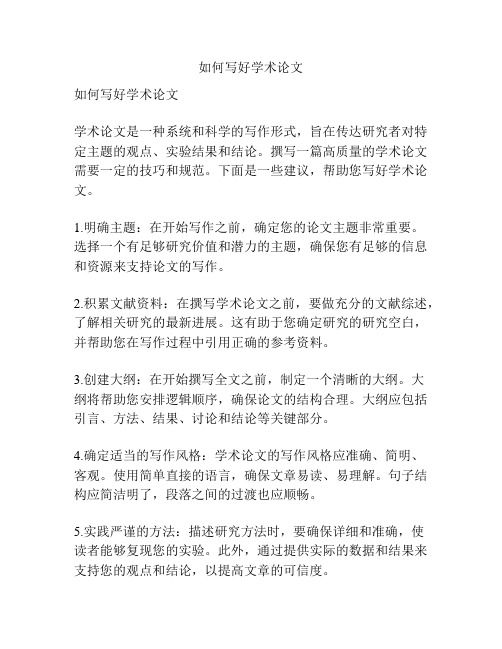
如何写好学术论文如何写好学术论文学术论文是一种系统和科学的写作形式,旨在传达研究者对特定主题的观点、实验结果和结论。
撰写一篇高质量的学术论文需要一定的技巧和规范。
下面是一些建议,帮助您写好学术论文。
1.明确主题:在开始写作之前,确定您的论文主题非常重要。
选择一个有足够研究价值和潜力的主题,确保您有足够的信息和资源来支持论文的写作。
2.积累文献资料:在撰写学术论文之前,要做充分的文献综述,了解相关研究的最新进展。
这有助于您确定研究的研究空白,并帮助您在写作过程中引用正确的参考资料。
3.创建大纲:在开始撰写全文之前,制定一个清晰的大纲。
大纲将帮助您安排逻辑顺序,确保论文的结构合理。
大纲应包括引言、方法、结果、讨论和结论等关键部分。
4.确定适当的写作风格:学术论文的写作风格应准确、简明、客观。
使用简单直接的语言,确保文章易读、易理解。
句子结构应简洁明了,段落之间的过渡也应顺畅。
5.实践严谨的方法:描述研究方法时,要确保详细和准确,使读者能够复现您的实验。
此外,通过提供实际的数据和结果来支持您的观点和结论,以提高文章的可信度。
6.合理使用引用:学术论文必须正确引用他人研究中的观点和资料。
引用文献不仅可以帮助您支持自己的观点,还可以展示您对该领域的理解和广泛阅读。
请遵循适当的引用规范,如APA、MLA等。
7.编辑和校对:将所有观点和资料组织到论文中后,请花时间对其进行编辑和校对。
注意语法、拼写和标点错误,并确保论文的结构和逻辑流程清晰。
8.接受反馈:请主动寻求他人的意见和反馈。
您可以请同事、导师或专家来审查您的论文。
他们的反馈和建议可以帮助您改进论文的质量和可读性。
9.注重细节:确保在引用、格式、图表和参考文献等方面遵循期刊或学术机构的要求。
不遵守这些细节可能会导致您的论文被拒绝。
10.持之以恒:写一篇出色的学术论文需要时间和努力。
请坚持,并不断改进您的写作技巧。
与同行交流并参与学术研讨会等活动也可以提高您的写作能力。
如何撰写一篇高质量的学术论文步骤与技巧

如何撰写一篇高质量的学术论文步骤与技巧在学术界,写作一篇高质量的学术论文既是一项挑战,也是一项重要的技能。
一篇高质量的学术论文不仅能够提升作者个人的学术声誉,也有助于促进学术界的发展。
然而,许多人被写作一篇高质量的学术论文所困扰,不知道从何着手。
本文旨在提供一些撰写高质量学术论文的步骤与技巧,帮助读者在学术写作中取得更好的成果。
第一步:确定研究主题要撰写一篇高质量的学术论文,首先要确定一个明确的研究主题。
选择一个研究主题时,应注意其与学科领域的重要性和相关性。
同时,还需要确保研究主题能够提供足够的研究材料和数据支撑。
第二步:进行文献综述在撰写学术论文之前,进行文献综述非常重要。
通过阅读相关领域的文献,可以了解该领域的最新研究进展和研究方法。
文献综述还可以帮助我们确定我们的研究问题和研究方法,找到与我们研究主题相关的关键概念和理论框架。
第三步:制定论文结构一篇高质量的学术论文应具备清晰的结构。
通常,学术论文采用引言、文献综述、研究方法、结果与讨论以及结论等组成的结构。
在撰写论文之前,我们可以先制定一个详细的纲要,将各个部分的重要内容列出来,以确保论文结构的合理性与连贯性。
第四步:合理规划时间撰写一篇高质量的学术论文需要充足的时间和精力。
因此,在开始写作之前,我们应该制定一个合理的时间计划,确保有足够的时间完成各个阶段的任务。
合理的时间规划能够帮助我们提高效率,并避免产生过多的压力和焦虑。
第五步:精确和准确的表达学术论文的写作要求语言精确和准确。
在写作过程中,我们应注意使用准确的术语和概念,避免使用模糊和含糊不清的表达。
此外,我们还应该注意语句通顺、逻辑严谨,以确保读者能够顺利理解我们的观点和研究成果。
第六步:重视数据分析和实验证明学术论文的可信度来自于充分的数据分析和实验证明。
在论文撰写过程中,我们要确保使用有效的数据分析方法,对数据进行准确的解释和统计。
同时,我们还应该充分依据实验、调查或者案例分析等来证明我们的观点,以提高论文的可信度。
学术论文写作技巧与规范
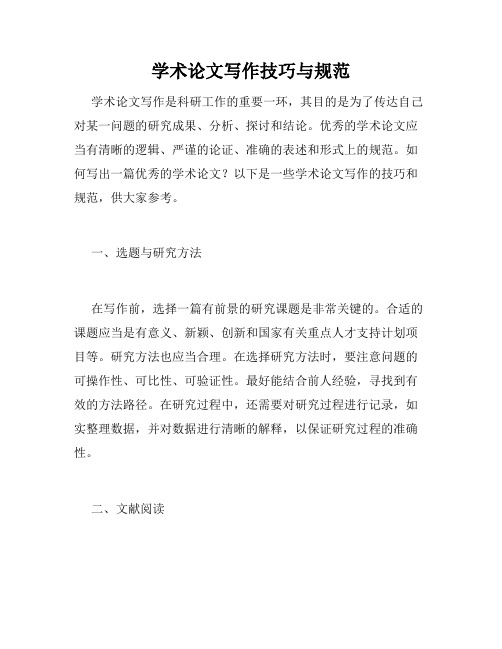
学术论文写作技巧与规范学术论文写作是科研工作的重要一环,其目的是为了传达自己对某一问题的研究成果、分析、探讨和结论。
优秀的学术论文应当有清晰的逻辑、严谨的论证、准确的表述和形式上的规范。
如何写出一篇优秀的学术论文?以下是一些学术论文写作的技巧和规范,供大家参考。
一、选题与研究方法在写作前,选择一篇有前景的研究课题是非常关键的。
合适的课题应当是有意义、新颖、创新和国家有关重点人才支持计划项目等。
研究方法也应当合理。
在选择研究方法时,要注意问题的可操作性、可比性、可验证性。
最好能结合前人经验,寻找到有效的方法路径。
在研究过程中,还需要对研究过程进行记录,如实整理数据,并对数据进行清晰的解释,以保证研究过程的准确性。
二、文献阅读在撰写学术论文之前,需要大量的文献阅读,这有利于扩大视野,挑选出有用的研究范式和观点,还可以了解前人的研究方法和相关结论,并为自己的文献综述奠定基础。
初期文献阅读应当全面,深入,尽量查找权威性的数据库,包括学术期刊、学术会议论文集和学术专著等。
文献阅读中虽然需要借鉴前人的研究成果,但是在引用他人研究成果时,必须注明出处,并不得直接复制原文,必须经过自己的理解和评述,不能轻易地转述前人观点。
三、论文组织结构良好的学术论文应该有清晰的结构,严谨的逻辑和完整的内容。
学术论文应由导言、文献综述、研究方法、研究结果、分析与讨论以及结论等部分组成。
其中,导言应描述研究背景并概括论文的意义。
文献综述则应描述已有研究者在该领域的发现和理论,并归纳出论文中存在的研究问题。
研究结果应提供实际可操作的数据或者证据,而分析与讨论部分需要针对数据或证据进行综合分析,甚至对原有问题进行修正或拓展。
结论部分应该对论文中的问题进行总结,提供有实质性的结论,并展望未来研究。
四、语言表达在学术论文写作中,语言应该尽可能准确,言简意赅,不应使用过于华丽的词语。
特别是在翻译中,不应只是单纯地进行翻译,而是应该在保证翻译准确的前提下,注意调整语言表述的习惯和规范,表述应该符合学术圈中的用语、命名方式和术语规定等。
论文写作中的七个高效撰写技巧

论文写作中的七个高效撰写技巧在学术界和研究领域,撰写论文是一项重要的任务。
无论是本科毕业论文、硕士论文还是博士学位论文,高效的写作技巧能够帮助研究人员更好地组织思路、表达观点,并提高论文质量。
本文将介绍论文写作过程中的七个高效撰写技巧,旨在帮助读者提升论文写作的能力。
一、明确目标与大纲在撰写论文之前,明确写作目标和大纲是非常重要的。
目标可以是论文的研究问题、研究目的以及预期结果。
大纲则是整篇论文的框架结构,包括引言、方法、结果和讨论等部分。
明确目标和大纲可以帮助作者系统化地整理研究思路,提高写作效率。
二、合理安排时间合理安排时间是高效撰写论文的关键。
制定一个详细的时间表,包括研究、写作、修改和校对等环节,以确保每个环节都有足够的时间进行。
设定合理的里程碑,每完成一个阶段即可得到积极的反馈,进一步激励自己进入下一个阶段。
三、全面查阅资料撰写论文需要充分查阅相关的文献资料。
通过阅读文献,可以深入了解研究领域的前沿进展,并有助于构建自己的研究框架和论点。
在查阅资料的过程中,要保持批判性思维,选择权威可靠的文献进行参考。
四、合理组织论文结构一个清晰、连贯的论文结构对于读者来说是非常重要的,同时也能提升论文的可读性。
在写作过程中,要合理组织段落,使用合适的过渡词语来连接不同的观点和论据。
此外,每个段落应该有明确的主题句,并确保论点的逻辑顺序和层次结构。
五、精炼表达语言语言表达是撰写论文过程中的关键要素。
精炼的语言可以提升读者的理解和阅读体验。
在写作中,要注意使用简洁、准确的词汇和句子结构。
避免使用过于复杂或冗长的句子,同时保持语句的流畅和连贯。
六、注重文献引用在学术写作中,准确、规范的文献引用非常重要。
遵循相关的引用规范,如APA、MLA等,能够确保论文的学术诚信性。
在撰写论文时,要及时并正确地引用他人的观点和研究成果,并在参考文献列表中列出所有引用的文献来源。
七、反复修改与校对撰写论文后,反复修改与校对是必不可少的步骤。
论文写作中的学术写作风格和表达技巧
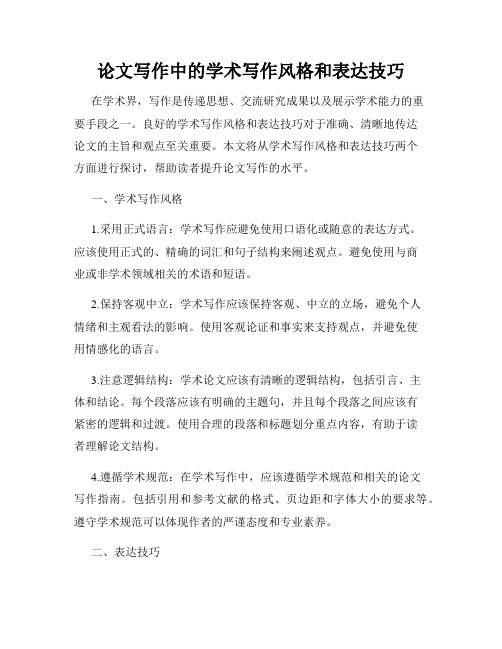
论文写作中的学术写作风格和表达技巧在学术界,写作是传递思想、交流研究成果以及展示学术能力的重要手段之一。
良好的学术写作风格和表达技巧对于准确、清晰地传达论文的主旨和观点至关重要。
本文将从学术写作风格和表达技巧两个方面进行探讨,帮助读者提升论文写作的水平。
一、学术写作风格1.采用正式语言:学术写作应避免使用口语化或随意的表达方式。
应该使用正式的、精确的词汇和句子结构来阐述观点。
避免使用与商业或非学术领域相关的术语和短语。
2.保持客观中立:学术写作应该保持客观、中立的立场,避免个人情绪和主观看法的影响。
使用客观论证和事实来支持观点,并避免使用情感化的语言。
3.注意逻辑结构:学术论文应该有清晰的逻辑结构,包括引言、主体和结论。
每个段落应该有明确的主题句,并且每个段落之间应该有紧密的逻辑和过渡。
使用合理的段落和标题划分重点内容,有助于读者理解论文结构。
4.遵循学术规范:在学术写作中,应该遵循学术规范和相关的论文写作指南。
包括引用和参考文献的格式、页边距和字体大小的要求等。
遵守学术规范可以体现作者的严谨态度和专业素养。
二、表达技巧1.准确地表达观点:在学术写作中,需要准确地表达自己的观点。
使用清晰、简洁的语言,避免使用模糊或含糊不清的词汇。
使用术语或特定概念时,应该确保读者能够理解其含义。
2.避免冗长和无关信息:学术写作应该精炼、简明。
避免冗长的句子和过多的修辞。
只保留与主题相关的信息,清楚地阐述观点,避免出现无关或重复的内容。
3.使用恰当的引用和参考文献:在学术论文中,合理引用他人的研究成果是必要的。
使用恰当的引用格式,包括直引、间接引用和注释等,以支持自己的观点或提供证据。
同时,务必正确地列出参考文献,使读者能够查证相关资料。
4.注意语法和标点符号:学术写作需要注意语法和标点符号的正确使用。
避免语法错误、句子片段和冗长的从句。
正确使用标点符号,确保句子的结构清晰、逻辑流畅。
总结起来,学术写作风格和表达技巧对于撰写一篇优秀的论文至关重要。
学术论文的写作技巧

学术论文的写作技巧1.确定论文的结构:学术论文通常包含引言、文献综述、方法、实验结果和讨论等部分。
结构清晰,有助于读者理解和跟踪研究思路。
2.引言部分:引言部分是论文的开篇,应该有吸引人的内容来引起读者的兴趣。
此外,阐明研究问题的重要性,并提供相关的背景知识以便读者理解。
3.文献综述:文献综述是对已有研究的回顾和总结,能够显示你对该领域的了解和贡献。
要确保文献综述内容的准确性和客观性,避免对已有研究的敷衍和错误评价。
4.方法部分:在方法部分,详细描述你用于解决问题的实验设计和过程。
注意以清晰简洁的语言描述方法,让读者能够准确地理解你的研究方法。
5.结果部分:结果部分应该阐明你的研究结果,并以图表和统计数据等形式进行展示。
确保结果的准确性和完整性,并避免对结果的主观解读。
同时,可以根据实验结果进行详细的讨论和分析。
6.讨论部分:在讨论部分,与已有的研究进行比较,并解释你的研究结果。
讨论部分需要清晰地表达你的研究发现,并提出进一步研究或改进的建议。
7.提高写作效果:选择恰当的词汇和语句结构,避免使用模糊或含糊不清的表达方式。
句子应该简洁明了,并使用正确的语法和标点符号。
此外,使用引用来支持你的观点,并遵循所使用的引用格式的规范。
9.学术诚信:在写作学术论文时,要遵循学术诚信的原则,确保你的研究具有可靠性和可重复性。
引用使用他人的研究成果,避免剽窃和抄袭的行为。
10.反复修改:写作是一个反复修改的过程,通过多次修改和修订,让你的思路更加清晰,并确保语言表达的准确性。
总之,学术论文是展示研究成果的重要方式,通过合适的结构、明确的写作目标和质量上乘的写作,可以提高论文的影响力和可读性。
始终坚持学术诚信原则,不断持续完善研究和写作技巧,相信你将能够撰写出优秀的工科学术论文。
论文写作技巧有效撰写方法和材料部分
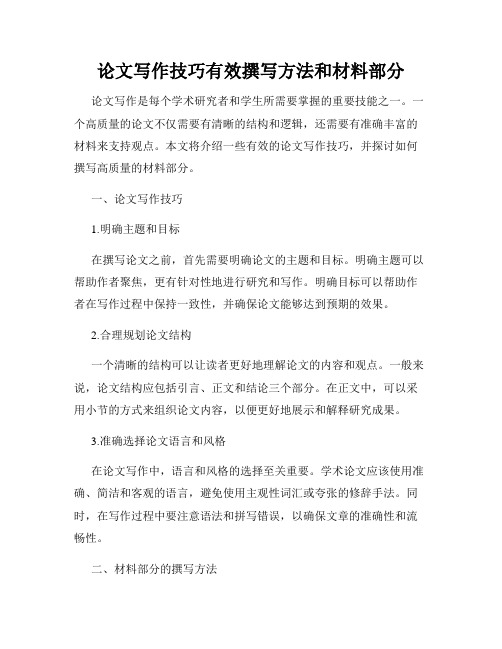
论文写作技巧有效撰写方法和材料部分论文写作是每个学术研究者和学生所需要掌握的重要技能之一。
一个高质量的论文不仅需要有清晰的结构和逻辑,还需要有准确丰富的材料来支持观点。
本文将介绍一些有效的论文写作技巧,并探讨如何撰写高质量的材料部分。
一、论文写作技巧1.明确主题和目标在撰写论文之前,首先需要明确论文的主题和目标。
明确主题可以帮助作者聚焦,更有针对性地进行研究和写作。
明确目标可以帮助作者在写作过程中保持一致性,并确保论文能够达到预期的效果。
2.合理规划论文结构一个清晰的结构可以让读者更好地理解论文的内容和观点。
一般来说,论文结构应包括引言、正文和结论三个部分。
在正文中,可以采用小节的方式来组织论文内容,以便更好地展示和解释研究成果。
3.准确选择论文语言和风格在论文写作中,语言和风格的选择至关重要。
学术论文应该使用准确、简洁和客观的语言,避免使用主观性词汇或夸张的修辞手法。
同时,在写作过程中要注意语法和拼写错误,以确保文章的准确性和流畅性。
二、材料部分的撰写方法材料部分是论文的重要组成部分,它应该提供可靠和丰富的证据来支持论文的观点。
以下是一些撰写材料部分的有效方法。
1.综述和分析相关研究成果在撰写材料部分之前,先综述和分析已有的相关研究成果。
这可以帮助作者了解当前领域的研究现状和发展趋势,同时也可以为作者提供一个基础,从而更有针对性地选择和撰写材料。
2.使用可靠和权威的文献资料在选择材料时,要确保使用可靠和权威的文献资料。
可靠的来源包括学术期刊、专业书籍和可信的在线数据库。
避免使用互联网上没有经过验证的信息,以免给论文带来不准确的观点和结论。
3.提供具体的数据和事实为了增强论文的可信性和说服力,材料部分应提供具体的数据和事实来支持观点。
这些数据和事实可以是实验结果、调查数据或其他相关的统计信息。
同时,要确保这些数据和事实的来源明确并可追溯。
4.引用和注释材料来源在引用和注释材料来源时,要遵循学术论文的规范。
学术论文写作技巧提升论文质量的关键步骤
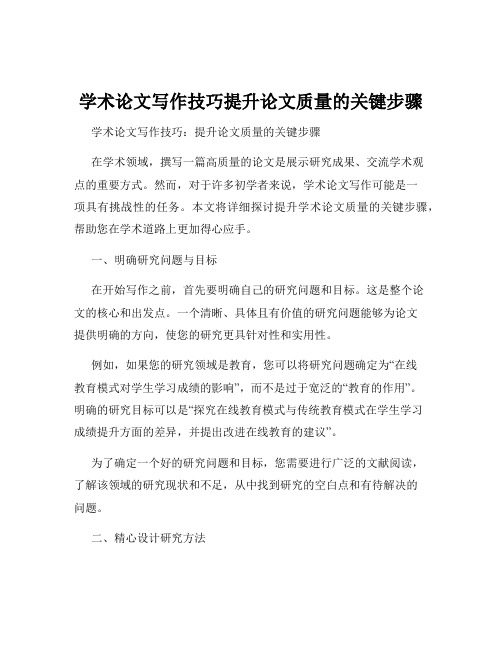
学术论文写作技巧提升论文质量的关键步骤学术论文写作技巧:提升论文质量的关键步骤在学术领域,撰写一篇高质量的论文是展示研究成果、交流学术观点的重要方式。
然而,对于许多初学者来说,学术论文写作可能是一项具有挑战性的任务。
本文将详细探讨提升学术论文质量的关键步骤,帮助您在学术道路上更加得心应手。
一、明确研究问题与目标在开始写作之前,首先要明确自己的研究问题和目标。
这是整个论文的核心和出发点。
一个清晰、具体且有价值的研究问题能够为论文提供明确的方向,使您的研究更具针对性和实用性。
例如,如果您的研究领域是教育,您可以将研究问题确定为“在线教育模式对学生学习成绩的影响”,而不是过于宽泛的“教育的作用”。
明确的研究目标可以是“探究在线教育模式与传统教育模式在学生学习成绩提升方面的差异,并提出改进在线教育的建议”。
为了确定一个好的研究问题和目标,您需要进行广泛的文献阅读,了解该领域的研究现状和不足,从中找到研究的空白点和有待解决的问题。
二、精心设计研究方法一旦确定了研究问题和目标,接下来就要设计合适的研究方法。
研究方法的选择直接影响到研究结果的可靠性和有效性。
常见的研究方法包括实证研究(如实验、调查、观察等)、理论研究(如文献综述、概念分析等)和混合研究(结合多种研究方法)。
例如,如果您的研究问题是关于某种药物对疾病的治疗效果,那么可能需要进行实验研究;如果是探讨某个哲学概念的内涵和演变,文献综述和概念分析则更为合适。
在描述研究方法时,要详细说明研究的步骤、样本的选择、数据的收集和分析方法等,以便读者能够评估研究的科学性和可信度。
三、广泛收集和整理资料充足且准确的资料是撰写高质量学术论文的基础。
资料的来源可以包括图书馆的书籍和期刊、学术数据库、网络资源等。
在收集资料时,要注意资料的权威性、时效性和相关性。
对于收集到的资料,要进行认真的整理和分类。
可以使用笔记软件或卡片的方式,将重要的观点、数据和引用记录下来,并注明出处。
学术论文的写作要求及技巧

学术论文的写作要求及技巧学术论文是一种系统性的学术写作,旨在研究一些问题或回答一些假设,并通过论证和分析提供可靠的结论。
下面是学术论文写作的要求和技巧:1.主题选择:选择一个狭窄但有足够研究空间的主题。
确保你对这个主题感兴趣,并且有足够的资源和文献支持。
2.文献综述:在写作论文之前,进行文献综述对于论文的完成至关重要。
通过检索相关的学术文献和资源,了解研究领域的最新进展和观点,并确定你的研究目标和方法。
3.结构规划:合理规划论文结构,包括引言、方法、结果和讨论等部分。
确保每个部分都有清晰的目标和逻辑顺序。
4.引言和问题陈述:在引言中提出你的问题陈述,并解释研究的意义。
确保问题清晰明确,并能够启发读者对该问题的思考。
5.方法论:描述你用于研究的方法,并解释这些方法为什么适用于你的研究。
提供足够的细节,使读者能够复制你的研究。
6.结果呈现:清晰地呈现你的研究结果,可以使用表格、图表和其他可视化方式。
确保结果与你的问题陈述和方法相一致,并根据需要进行解释和分析。
7.讨论和结论:对你的研究结果进行评论和评估,并解释它们与其他研究结果的关系。
在结论中总结你的主要发现,并提出进一步的研究建议。
9.语言清晰:使用简洁明了、准确的语言表达你的观点。
避免使用模糊、含糊不清或过于主观的语言。
10.科学性和客观性:确保你的论文基于可靠的证据和数据,并保持客观性和科学性。
避免个人偏见和情感色彩。
12.多次审阅:多次审阅并修改你的论文,特别是在内容和结构方面。
请保证论文的连贯性和一致性。
综上所述,写作学术论文需要严谨的思考、仔细的计划和适当的技巧。
遵循这些要求和技巧,可以帮助你写出高质量和有说服力的学术论文。
学术写作的技巧与规范要求
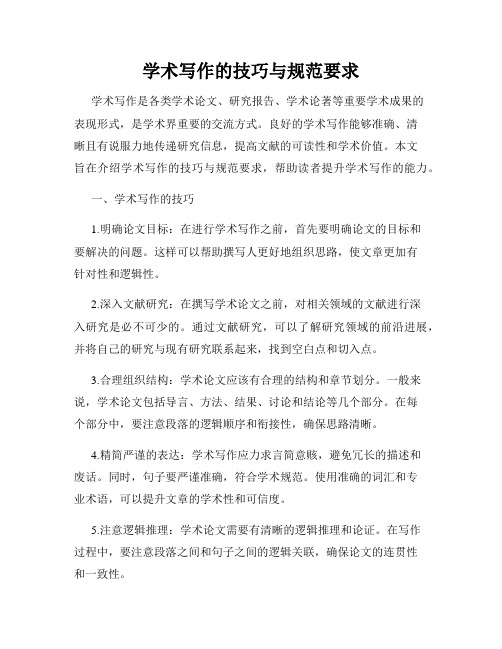
学术写作的技巧与规范要求学术写作是各类学术论文、研究报告、学术论著等重要学术成果的表现形式,是学术界重要的交流方式。
良好的学术写作能够准确、清晰且有说服力地传递研究信息,提高文献的可读性和学术价值。
本文旨在介绍学术写作的技巧与规范要求,帮助读者提升学术写作的能力。
一、学术写作的技巧1.明确论文目标:在进行学术写作之前,首先要明确论文的目标和要解决的问题。
这样可以帮助撰写人更好地组织思路,使文章更加有针对性和逻辑性。
2.深入文献研究:在撰写学术论文之前,对相关领域的文献进行深入研究是必不可少的。
通过文献研究,可以了解研究领域的前沿进展,并将自己的研究与现有研究联系起来,找到空白点和切入点。
3.合理组织结构:学术论文应该有合理的结构和章节划分。
一般来说,学术论文包括导言、方法、结果、讨论和结论等几个部分。
在每个部分中,要注意段落的逻辑顺序和衔接性,确保思路清晰。
4.精简严谨的表达:学术写作应力求言简意赅,避免冗长的描述和废话。
同时,句子要严谨准确,符合学术规范。
使用准确的词汇和专业术语,可以提升文章的学术性和可信度。
5.注意逻辑推理:学术论文需要有清晰的逻辑推理和论证。
在写作过程中,要注意段落之间和句子之间的逻辑关联,确保论文的连贯性和一致性。
二、学术写作的规范要求1.文献引用规范:在学术论文中,引用文献是非常重要的。
引用他人的成果可以增加学术论文的可信度和权威性。
在引用文献时,要符合学术规范,包括格式、引用顺序、引用标注等。
2.数据和结果的准确性:学术论文应该基于准确和可靠的数据进行研究和分析,并确保结果的准确性和可重复性。
任何伪造和篡改数据的行为都是严重违反学术道德的。
3.遵循学术道德规范:学术写作需要遵循学术道德规范,包括尊重他人的成果和知识产权,不造假、不抄袭和不剽窃他人成果。
同时,学术写作还应当注重公正和客观,不进行不当的评价和攻击。
4.编辑和排版要求:学术论文在编辑和排版时,要符合学术期刊或出版社的要求。
学术论文写作技巧
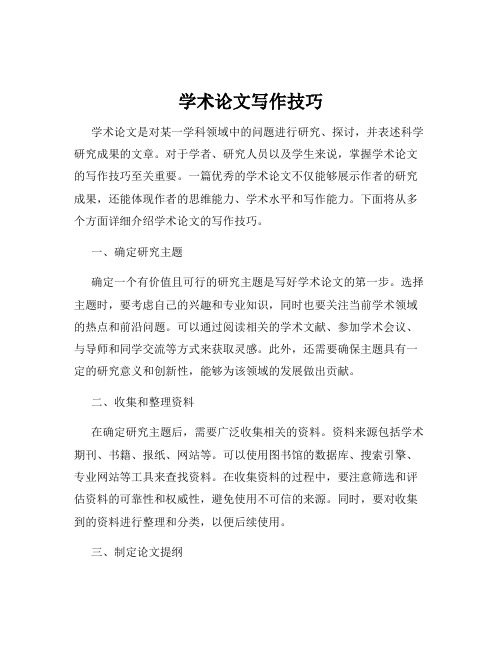
学术论文写作技巧学术论文是对某一学科领域中的问题进行研究、探讨,并表述科学研究成果的文章。
对于学者、研究人员以及学生来说,掌握学术论文的写作技巧至关重要。
一篇优秀的学术论文不仅能够展示作者的研究成果,还能体现作者的思维能力、学术水平和写作能力。
下面将从多个方面详细介绍学术论文的写作技巧。
一、确定研究主题确定一个有价值且可行的研究主题是写好学术论文的第一步。
选择主题时,要考虑自己的兴趣和专业知识,同时也要关注当前学术领域的热点和前沿问题。
可以通过阅读相关的学术文献、参加学术会议、与导师和同学交流等方式来获取灵感。
此外,还需要确保主题具有一定的研究意义和创新性,能够为该领域的发展做出贡献。
二、收集和整理资料在确定研究主题后,需要广泛收集相关的资料。
资料来源包括学术期刊、书籍、报纸、网站等。
可以使用图书馆的数据库、搜索引擎、专业网站等工具来查找资料。
在收集资料的过程中,要注意筛选和评估资料的可靠性和权威性,避免使用不可信的来源。
同时,要对收集到的资料进行整理和分类,以便后续使用。
三、制定论文提纲提纲是论文的框架和结构,能够帮助作者组织思路和安排内容。
在制定提纲时,要先明确论文的引言、正文和结论等部分的主要内容。
正文部分可以根据研究的逻辑和结构进一步细分章节和段落。
提纲的层次要清晰,逻辑要严密,各部分之间要过渡自然。
四、撰写引言引言是论文的开头部分,其主要目的是引出研究主题,阐述研究的背景、意义和目的。
引言要能够吸引读者的兴趣,让他们了解为什么这个研究是重要的。
可以通过提出问题、介绍相关的研究现状、指出研究的空白点等方式来引入主题。
五、展开正文论述正文是论文的核心部分,要对研究问题进行深入的分析和探讨。
在论述过程中,要注意逻辑清晰、论证充分。
可以采用多种论证方法,如举例论证、对比论证、因果论证等。
同时,要合理使用图表和数据来支持观点,增强论文的说服力。
每个段落都要有一个明确的主题句,围绕主题句展开论述。
学术论文怎么写(范文)

学术论文怎么写(范文)学术论文是展示学生研究能力和学术知识的重要方式。
写作一篇出色的学术论文需要一定的技巧和方法。
下面将介绍一种写作学术论文的方法,希望能给读者提供一些指导。
1. 选择合适题目选择一个合适的题目是写作学术论文的第一步。
题目应当明确、具有研究价值,并能激发读者的兴趣。
在选择题目时,可以参考已有的研究文献和领域的研究热点。
2. 确定论文结构一个清晰的结构能够帮助读者更好地理解论文的内容。
通常,学术论文的结构包括引言、背景介绍、相关研究、方法、结果与讨论以及结论等部分。
在写作过程中,应该确保各个部分的逻辑连贯性,使论文内容更有条理。
3. 进行深入的文献综述在开始写作之前,对相关的研究文献进行深入的综述是必要的。
通过文献综述,可以了解到已有研究的现状和不足之处,并为自己的研究提供理论依据和指导。
4. 提出研究问题或假设学术论文应该明确提出研究问题或假设。
研究问题或假设应当具有可测量性和可验证性,并能够引导后续的研究工作。
5. 选择合适的研究方法根据研究问题或假设,选择合适的研究方法进行实证研究。
研究方法应当科学可靠,并能够回答研究问题或验证假设。
6. 数据收集和分析根据选择的研究方法,进行数据的收集和分析。
数据的收集可以通过实地调查、实验、问卷调查等方式进行。
数据的分析则需要使用适当的统计方法和数据分析工具。
7. 结果与讨论根据数据分析的结果,撰写结果与讨论部分。
在结果部分,应当客观地呈现数据,并解释研究结果。
在讨论部分,可以对结果进行解释,并与已有的研究进行比较和分析。
8. 写作技巧和注意事项在写作学术论文时,需要注意以下几点:- 使用清晰简洁的语言表达思想,避免使用含糊不清或难以理解的术语;- 引用文献时应遵循学术规范,确保准确性和可查证性;- 注重论文的逻辑结构和段落间的衔接,使读者能够轻松理解论文的内容;- 严禁抄袭他人的作品,应当注重论文的原创性和创新性;- 在写作过程中,适当使用图表、图像或引用,能够更好地支持论文的内容。
学术论文写作指导

学术论文写作指导学术论文是学术界重要的交流方式,它不仅能够展示研究成果,还能促进学术进步。
然而,对于许多人来说,写作一篇高质量的学术论文是一项挑战。
本文将为您提供一些建议和指导,帮助您写出一篇出色的学术论文。
一、选择合适的主题选择一个合适的主题是论文写作的第一步。
主题应该与您的研究领域相关,并且具有一定的研究价值。
在选择主题时,可以参考最新的研究动态和学术期刊,了解当前热门话题和未来发展方向。
二、明确论文结构一个清晰的结构可以帮助读者理解您的论文。
一般来说,学术论文应包括引言、文献综述、研究方法、实验结果、讨论和结论等部分。
在写作过程中,您可以根据需要增加或调整各个部分的内容,但要保持逻辑连贯性。
1. 引言部分应该明确论文的研究目的和意义,并提出明确的研究问题。
同时,引言部分还应简要介绍相关研究的现状和研究方法。
2. 文献综述部分是对已有研究成果的总结和评价。
在撰写文献综述时,应该引用权威的学术文献,并对这些研究进行客观的评价和分析。
3. 研究方法部分应详细描述您的研究设计和实验方法。
这一部分应该具有可重复性,让其他研究者能够根据您的描述进行实验。
4. 实验结果部分是对实验数据的描述和分析。
在描述实验结果时,可以使用表格、图表或统计数据来展示数据。
同时,还应该对结果进行客观的分析和解释。
5. 讨论部分是对实验结果的解释和讨论。
在这一部分,您可以与前人的研究进行对比,分析结果的优点和不足,并提出改进和未来研究的方向。
6. 结论部分是对整个论文的总结和归纳。
在结论中,您可以再次强调研究的意义和贡献,并提出进一步的研究建议。
三、注意语言表达和逻辑结构在学术论文中,语言表达和逻辑结构非常重要。
以下是一些建议:1. 使用准确、简洁的语言表达研究内容。
避免使用过于复杂或模糊的词汇和句子结构。
2. 使用第三人称,避免使用第一人称。
学术论文应具有客观性,因此不应包含个人观点或情感。
3. 使用恰当的引用格式。
在引用他人的研究成果时,应使用适当的引用格式,如APA、MLA等。
怎样写好一篇学术论文?全

可编辑修改精选全文完整版如何着手写一篇学术论文准备阶段:1.坚持分类整理文献读文献是快速创作论文的不二途径,进行大量的文献阅读,能够快速获取基本知识,同时借鉴别人的论文框架与思路。
论文框架由文献来支撑,所以坚持分类整理文献,对于后期的写作具有重要的作用。
坚持分类整理文件,把同一个类型的文献放在同一个文件夹能够帮助你快速的找到自己想要的文献。
比如我做过新闻学的研究,就可以把研究新闻与VR的文献放在同一文件夹,把研究新闻+5G直播的论文放在同一文件夹等等。
2.坚持对文献进行注释在整理了相关文献后,在看文献时需要对文献进行注释,注释部分主要集中在重要的概念、重要引用的句子、重要的研究思路和不了解的专业术语等。
做好注释,以供后面需要的时候及时的查看和引用。
有必要的话,还可以整理word文档,把相应的重要的知识、思路进行汇总。
如果遇到不会的专业英文术语,这里提供一个方法。
在知网上高级检索关键词,输入你想要的专业中文术语,然后搜索,随便看一篇有英文文摘的论文,查看关键字即可获得。
写作阶段:在看了很多文献之后,论文的大概思路也清楚了,这个时候就要落实写作。
接下来很重要的一点是写论文框架,一切工作都是围绕这篇论文进行的。
针对研究的主题搭建论文框架,然后围绕这个框架添加内容,没必要等到万事俱备再来写论文,一篇好的论文是要经过不断的修改的。
如果你迟迟的不动笔,只会“拖产”。
举例:我想写一篇新闻与VR结合的分析。
论文框架如下:摘要:主要包括以下几个方面内容,首先,简述新闻与VR的必要性。
第二,研究方法简述,第三,结论简述。
引言:研究背景的简述和必要性;国内研究现状;国外研究现状;研究必要性,研究思路和方法简述。
方法:方式介绍,具体研究方法介绍,研究思路(根据具体情况写具体一点)。
️结论:放在末尾一部分写。
怎样写好一篇学术论文?从攻读硕士学位、博士学位到作为研究人员,几乎很少有人真正研究过如何写好一篇学术论文的问题。
在读书期间,导师一般是交给学生专业知识和获得专业知识的方法,而不会叫给学生写好论文的方法,从事研究之后,大多数人又忙于写论文,给予发表论文,而不会去考虑撰写论文的方法。
- 1、下载文档前请自行甄别文档内容的完整性,平台不提供额外的编辑、内容补充、找答案等附加服务。
- 2、"仅部分预览"的文档,不可在线预览部分如存在完整性等问题,可反馈申请退款(可完整预览的文档不适用该条件!)。
- 3、如文档侵犯您的权益,请联系客服反馈,我们会尽快为您处理(人工客服工作时间:9:00-18:30)。
Dr. Daniel McGowan 论文写作系列第五讲Good study design and forward planning如何做好研究设计和预先规划工作Rejection following peer review can mean a considerable amount of additional work for many authors to get their studies published. In the worst cases, their studies may be simplyun-publishable. Much heartbreak and hard work can be avoided by simply planning and designing your study properly in advance. In the long run, this will save you time, allowing you to get on with the research for your next big paper.No-one wants to have to repeat experiments because the controls were inappropriate or the case/sample numbers were insufficient to provide enough statistical power. Frequently though, researchers rush into experiments without making all the proper considerations, and this can result in delays when their manuscripts reach the peer review stage. Remembering a few basic principles of study design can help to reduce the risk of outright rejection and repeated experimentation.1. Have a hypothesis or research questionHaving a hypothesis or appropriate research question enables you to …frame‟ your research within an appropriate context, which in turn will help you apply the appropriate controls. It will also help you describe the rationale for your study when it is time to write it up. Having a hypothesis also means that the objectives of the study are clearly defined, thus reducing the chance that your study will be open-ended and possibly criticised for being incomplete. You can then logically work through these objectives and, importantly, present your results in a logical manner rather than haphazardly.2. Ensure that the appropriate methods are usedOnce you have a clear idea of the aims of your study, and the specific research question you are setting out to answer, you will need able to determine what methods would be appropriate to achieve these. Important considerations include deciding whether subjective, qualitative data will be sufficient to address your question, or whether there is a need for more quantitative methods. For basic science studies, such considerations might include the following questions. Will the combination of RT-PCR and in situ data be enough, or is there a need for qPCR? Is Western blotting alone sufficiently sensitive or do you need to also perform immunohistochemistry and cell counting experiments to show a difference between groups? For clinical studies, important considerations include the choice of controls, sample sizes, statistical tests and approach, all of which are described in more detail in the points below.3. Ensure that the appropriate controls are usedControls are included in experiments to rule out alternative hypotheses. There‟s an old saying that “nothing can be proven, only disproved”, and this is precisely why appropriate control s are necessary: to disprove any feasible alternative interpretations of the data you obtain and/or to eliminate or minimize the effects of extraneous variables. Consider what alternative hypotheses exist, and systematically rule them out by performing experiments that disprove them. There are generally two types of controls: positive and negative. Positive controls show that a negative result is not due to a failure of the experimental system. Negative controls provide an indication of the …background noise‟ or baseline value with which to compare values from your experimental sample. In quantitative studies, a “relative control” or “housekeeping control” is required to show that changes in the apparent levels of a target gene or protein are not caused by differences in the amounts of protein or DNA in the sample. These levels can be used as a baseline to measure changes in relative levels of a target gene or protein. Commonhousekeeping molecules include β-actin and GAPDH. In clinical trials, subjects in a placebo group in intervention trials, and normal control subjects in observational trials, need to be matched as closely as possible to those in the treatment or disease group in terms of age, sex and numerous other potential confounding factors. In randomized controlled trials, accepted procedures for assignment to groups also need to be followed (see, for example, the ICH good clinical practice guidelines at: /LOB/media/MEDIA482.pdf).4. Use sample sizes large enough to provide a definitive resultMany studies fail to achieve the desired impact or to fully support a given hypothesis because the effect is too small or the variability too large to show statistical significance. Often this can be simply overcome by increasing the sample size. However, once a study has been performed and the data analyzed, it can be impossible to go back and increase the numbers without starting all over again. For this reason, pilot studies are often performed in advance of larger scale studies. Talk to a statistician. Determine the size of the effect of your treatment and/or the variability in your population before starting large-scale studies, and use this information to determine the sample size required to give you statistical power. Doing this can save you time, money and potential disappointment later.5. Use appropriate statistical tests to analyze your dataStatistical analysis of your data is essential to show that an effect is genuine and significant. Tests of significance demonstrate the robustness of your findings, essentially showing how unlikely it is that your findings were obtained …by chance‟. Are your data continuous or discrete? Are they normally distributed or non-normally distributed? The nature of your data will determine how they should be analyzed and what tests are appropriate. If in doubt, consult a statistician who will be able to advise you on the most appropriate tests to use and what these tests indicate. Determining the right tests to use in advance will save you having to repeat youranalyses if you got it wrong first time round, with the distinct possibility that no significant effect will be observed when the appropriate tests are used. For clinical trials, the following guidelines may be useful: /LOB/media/MEDIA485.pdf.6. Remove investigator and patient biasMany experiments involve subjective measurements or assessments performed by the investigators, as opposed to objective results provided by the experimental system. If the investigator has prior knowledge of the groups to which individuals/samples belong, then investigator bias is a distinct possibility, and this can invalidate any of the findings obtained. In such cases, where the investigator is a factor inherent in the experimental system, it is essential that the investigator is …blinded‟ to the groups to which individuals or samples belong. Doing so ensures the objectivity of the findings and improves their reliability. Such blinding can refer to treatment in an intervention trial, or to assessment or interpretation of clinical findings in an observational trial. Similarly, the outcome of a treatment could be influenced if a patient knows if they are receiving a placebo or drug; such patient bias should be avoided, by blinding the patient to the nature of the treatment. Being aware of the potential for bias before commencing experimentation can again save the need for time- and resource-consuming repeats.7. Comply with ethical requirementsThere are strict regulations regarding the use of human and animal subjects, and in many countries, regarding the use of stem cells, cell lines and genetically modified materials. Failure to comply with these regulations will prevent publication of your findings and could lead to legal issues; at best, it will limit the range of journals to which you can submit your findings. Make yourself aware of these regulations before you commence your study and ensure that all requirements are complied with so you don‟t encounter problems later on. As well as ethical requirements regarding experimentation, there are also strict guidelines provided by mostjournals regarding the requirements for authorship, and these also need to be complied with. Clinical trials should comply with the Declaration of Helsinki(/e/policy/b3.htm) in addition to any local requirements. Informed consent is essential for most trials involving human subjects. Animal studies should comply with local and national regulations, although many journals are now aligning themselves with standards such as the NIH “Guidelines for the Care and Use of Animals”(/regs/guide/guide.pdf). Finally, many journals require a statement describing who gave ethical approval for the study.8. Clinical study registrationMany top-tier journals now request that prospective clinical trials involving human participants should be registered online in an accessible database. Many journals will instantly reject studies of this type that have not been registered. More information on this can be found at/faq.pdf. International clinical trial registries include the Chinese Clinical Trials Register (/), the Japanese Primary Registries Network(http://rctportal.niph.go.jp/), The International Standard Randomised Control Trial Number database (/) and Clinical (/). Registration should be done before the first participant is enrolled, but many of the databases do allow retrospective registration. However, by registering the trial once you receive ethical consent you will save time and overcome a major obstacle to publication.All studies are different and therefore have different requirements regarding appropriate study design. The points above are just a few of the important considerations that should be made prior to the commencement of experimentation, and the general principles apply to a variety of different study types. It is true that sometimes even peer review fails to detect flaws in study design, as shown, for example, in the following report on randomized controlled clinical trialspublished in Chinese journals: /content/10/1/46. However, if you want your study to stand the test of time, be published in a top-tier journal and to be widely accepted by the international research community, then planning ahead and designing your study to make it robust and reliable will only serve to save you time, money and heartbreak later on.Overcoming the language barrierDr. Daniel McGowan 论文写作系列第四讲Overcoming the language barrier: writing in English for non-native authorsDr. Daniel McGowan将向大家展示“克服语言障碍,非英语母语科研人员如何写作?”“Journal editors, overloaded with quality manuscripts, may make decisions on manuscripts based on formal criteria, like gra mmar or spelling. Don‟t get rejected for avoidable mistakes; make sure your manuscript looks perfect” (quote from a senior executive at a large international publishing house).Scientific writing is difficult enough for many authors who have English as their first language; for non-native English-speaking authors, writing a paper in English represents a massive challenge that can make or break their paper‟s chances of publication. With increased pressure on publication space and increased demands on editors‟ time many journals are introducing language screening protocols to check submissions before they reach the editor‟s desk; some editors simply choose to overlook papers that are too poorly written to consider or send for review in the knowledge that, among the submissions they receive, will be well written studies containing interesting and robust science. However, all is not lost for non-nativeEnglish-speaking authors: by being aware of some of the most common scientific writinglanguage errors and how to avoid them, you can improve the quality of your paper and increase its chances of being accepted.It is helpful to think of the writing process in the same way that you think about performing experiments; that is, the language needs to be easily and accurately understood by the reader, without multiple possible interpretations arising. In experiments, we use controls to rule out alternative hypotheses. In language, we must avoid ambiguities and unnecessary text (such as repetition and redundancies) to get our message across clearly. Scientific writing should possess what I call the three “C”s: clarity, conciseness and correctness (accuracy). The key to achieving this is to be as brief and specific as possible without omitting any details that might be essential for the reader to fully understand your meaning. In other words, say no more than you need to accurately convey your message. Although writing that fails to meet this standard is sometimes described as “sloppy” or “lazy” writing, authors are frequent ly unaware that what they have written is unclear and ambiguous. Thus, attention to detail and an appreciation of how your writing could be misinterpreted are essential. What follows is just a small selection of error types that, when present in large numbers, could result in your paper going straight to the …rejected‟ pile.Articles/Plural vs singularArticles (a/the) are adjectives that modify nouns. Where they are used incorrectly the reader can be left wondering if you are referring to a specific thing or to a non-specific item or category. Worse, they could interpret the text incorrectly and make a wrong assumption. Incorrect use of articles can also lead to confusion relating to singular vs plural senses. The word “the” should be used in conjunction with a noun referring to a particular item or group of items (it can be used with both plural and singular nouns); for example, “the sections were/the section was then stained with H&E” implies that the sections you had referred to in recent sentences weres tained. By contrast, “a” should be used in conjunction with non-specific nouns; for example, “a section was then stained” infers that a single section, any section, was stained. “A” should only be used to refer to a single item or category, and should not be used in conjunction with plural nouns; that is, “a sections” would be incorrect. Asian authors frequently leave articles out of sentences making them sound awkward and unnatural, which would be the case when omitting the “the” in “adenovirus was injected into the fourth ventricle”.1. “The antibody was injected into the hippocampus…” (articles required to specify a particular antibody, presumably already referred to in the text, and a specific hippocampus, belonging to a subject already described).2. “A new method of extraction was devised…” (“a” used rather than “the” because this statement introduces this method to the reader; therefore it is non-specific at that time. Once introduced to the reader, “the new method of extraction” should be used to refe r to that method in the specific sense).Nouns are used in the plural sense by adding an “s” to the end (in most cases). In the absence of an article, it can sometimes be unclear if the wrong sense (plural vs singular) has been used. For example, in the se ntence “Acetyl group was added”, the reader is not clear whether the author means “An acetyl group was added” or perhaps “Acetyl groups were added”. Thus, when referring to multiple items, the plural sense should be used to avoid potential confusion. This is commonly forgotten when describing figures (use “arrowheads” rather than “arrowhead” where there is more than one in the figure; likewise, use “solid bars” rather than “solid bar” when referring to a bar chart with multiple bars).1. “A biopsy was obtained…” (describing a single biopsy).2. “Biopsies were obtained from eight patients…” (no article necessary unless these biopsieshad already been introduced to the reader, in which case they would need to be referred to in the specific sense “The biopsies were obtained…”).Commas, hyphens and “which”Used incorrectly these three elements of writing can introduce ambiguities, and the potential for subsequent misunderstanding, into your writing. For example, in the sentence “Because Aβ42 levels were elevated in 75% of AD patients in studies using our method [6,7], it is critical to obtain fresh samples”, moving the comma after method to follow the word “patients” (or addition of a new comma there) would completely change the meaning. Similarly, in the phrase “calcium-induced calcium release”, omission of the hyphen completely changes the meaning of the sentence. When the hyphen is present “calcium-induced” is a compound adjective modifying the noun “calcium release”; when the hyphen is absent, “induced” is a ve rb describing the effect of calcium on calcium release. Thus, it is critically important to use hyphens with such compound adjectives to avoid misunderstandings. However, no hyphen is required to combine an adverb and an adjective; for example “highly intense staining” and “high-intensity staining” are both correct, but “highly-intense staining” is not.1. “Glutamate receptors mediated synaptic plasticity…” (tells the reader that Glu receptors are involved in the development of synaptic plasticity).2. “Glu tamate receptor-mediated synaptic plasticity…” (identifies synaptic plasticity involving Glu receptors as the subject of the sentence; note the change from plural to singular because “receptor” is being used in a general sense and not to refer to a single receptor).The word “which”, when used incorrectly, can also induce considerable confusion. It is often used incorrectly instead of “that”. Both introduce clauses that modify nouns, but “that” should be used to introduce defining or restrictive clauses and “which” should be used to introduce non-defining or non-restrictive clauses. For example, in “the sections that were positive forGFP were subjected to cell counting procedures”, the “that” introduces a defining clause that defines exactly which sections were subjected to cell counting. By contrast, in “the sections, which were positive for GFP, were subjected to cell counting procedures”, the sections that were subjected to cell counting are rather loosely defined, possibly referring to sections that have been described in the previous or recent sentences. The clause about GFP positivity provides the reader with additional information, but is not essential to understand the meaning of the sentence; that is, it is disposable. Because “which” is used in this way, writers need to ensure that it is absolutely clear what the “which” is actually referring to, possibly whatever immediately precedes it (most commonly) or possibly the main subject of the sentence. For example, the sentence “microglia migrated to the site of the lesion, which was associated with increased levels of ED-1” is somewhat vague, because it is unclear if the “which” is referring to the lesion or to the migration of microglia. If there is ever any doubt about such a sentence, it is best to re phrase it completely; for example “migration of microglia to the site of the lesion was associated with increased levels of ED-1” or “microglia migrated to the site of the lesion, and immunohistochemical analysis revealed increased levels of ED-1 at this s ite”, both of which are unambiguous.1. “Data were normalised to the housekeeping gene actin, which was used as an internal reference…” (here, the “which” refers to actin, which is therefore the subject of the following clause).2. “Data were normalised to the internal reference housekeeping gene actin, revealing increases in the levels of…” (to refer to the analyzed data in a subsequent clause, “which” would be inappropriate and introduce an ambiguity).RespectivelyThe word respectively is frequently misused by native and non-native English-speaking authorsalike, and, as with the other elements described above, its misuse can lead to confusion and ambiguities. It is often clearer not to use this term at all, but it can be useful to economise on words where there are two corresponding lists. For example, it is quite useful in the sentence “The latencies to withdrawal from a painful stimulus in control and transgenic mice were 3 s and 2 s, respectively”, meaning that control mice withdrew after 3 s and trans genic mice withdrew after 2 s. If describing something much shorter than “The latencies to withdrawal from a painful stimulus”, for example average weights, respectively is not necessary; “Control mice weighed 20±3 g and transgenic mice weighed 17±2 g” is better than “Control mice and transgenic mice weighed 20±3 g and 17±2 g, respectively”, which contains one additional word. Note that “respectively” can only be used to refer to two corresponding lists at one time, and cannot be used to refer to more. Thus, the sentence “The latencies to withdrawal from 5 g and 10 g painful stimuli in control and transgenic mice were 3 s and 2 s, respectively” is incorrect and impossible to understand.“The proportions of monocytes positive for CD163, CD7 and CD11a were 45%, 63% and 70%, respectively” (the “respectively” makes clear that the three percentages refer to each of the three markers in the same order).ComparisonsComparisons are frequently made in the results sections of papers, and it is especially important to compare “like with like”. One common error made by non-native authors is overlooking this simple rule and leaving the reader to make an assumption about what is being compared. At best, the language will appear unnatural but the meaning clear; at worst, the wrong meaning can be imparted. As an example, the sentence “Expression levels of p53 in smokers were compared with non-smokers” should actually be “Expression levels of p53 in smokers were compared with those in non-smokers”. Another frequent error with comparisons is the use of relativeterms (for example, higher, greater, more) without a reference. In the sentence “transgenic mice showed higher levels of cortisol” it is unclear what these levels were higher than; thus, a “than clause”, such as “than control mice”, is required. The reader might make this assumption automatically, but in some cases alternative inferences will be possible; the goal of accurate scientific writing has to be the removal of all assumption. Because comparisons of results are critical to their interpretation and, ultimately, their significance, it is critical that you convey to the reader exactly what is being compared. Finally, the word “between” should be used for comparisons of two findings, but “among” should be used for compa risons of three or more. 1. “The levels of ubiquitinated proteins were higher in patients than in control subjects” (the “than clause” provides a reference for the term “higher”).2. “The levels of ubiquitinated proteins in patients were higher than those in control subjects” (unlike the first example, where patients and controls are both on the same side of the comparing term, that is, they are both mentioned after “higher”, here, patients and controls appear either side of the comparing term; therefore, i t is necessary to add “than those” to compare like with like).3. “There was no significant difference in the levels of ubiquitinated proteins between patients and controls” (“between is appropriate here for a comparison of two groups).4. “There were no s ignificant differences in the levels of ubiquitinated proteins among AD patients, PD patients and controls” (among is appropriate for comparisons of more than two groups; note the change to the plural differences because more than one type of difference is possible with more than two groups).Protein and gene nomenclatureOne very common cause of confusion is use of the incorrect nomenclature to describe changes in the levels of genes, their mRNAs or the proteins that they encode. Constant changing fromdescribing gene expression levels to protein levels and back again can also add to the confusion, especially because the names are often the same. Therefore, it needs to be completely clear to the reader exactly what level you are talking about. Nomenclature differs among species, but generally gene names should be described in italics and protein names in normal font. Case (upper vs lower) is often used to distinguish between species: generally, for mouse, rat and chicken, gene names are spelt with an upper case first letter and the rest in lower case; for humans, primates and some domestic species, gene names are spelt with all capital letters. Descriptions of mRNAs generally use the gene name (for example, “levels of p53 mRNA”) or you can refer to the mRNA “for” a given protein (for example “levels of the mRNA for p53”). The word “expression” is usually used to describe gene expression and can induce confusion when used to describe protein and mRNA levels; in most cases referring to proteins the word “expression” can simply be replaced with the word “level” (or “levels”). Be aware of the correct nomenclature for your species of subject and ensure that everywhere you refer to a protein, gene or mRNA by name in the text it is completely clear which of those you are referring to.1. “Expression of the Igf1 gene was increased in our transgenic mice” (use if italics and the word “gene” ensure that no confusion is possible here).2. “The levels of IGF1 mRNA were elevated in our patient group” (correct nomenclature fo r human genes).3. “The serum IGF1 levels were elevated in the transgenic mice” (here, it is clear that the protein is being referred to; capitals are appropriate in this case, even though the species is mouse, because it is the correct nomenclature for the mouse protein).SummaryThese are just a few of the most common errors made by non-native English-speaking authorsin their scientific writing. There are of course many more that can‟t be dealt with here, but they all have the same result: a loss of clarity and/or introduction of ambiguity. If you apply the three “C”s when writing your next paper, with an awareness of some of the traps that can lead to ambiguities or a loss of clarity, you will automatically improve your chances of getting your study published. If you also focus on removing any repetition and redundancy, and apply attention to detail to ensure that your meaning is clearly conveyed in each sentence, you will increase them further. As a general rule, it is a good idea to keep sentences simple, using shorter expressions wherever possible, rather than long, complicated and confusing. The slogan for the Beijing Olympics was “One world, One dream”; when it comes to scientific writing you should think “One sentence, One idea”. The simplest solutio n is always the best.The cover letterDr. Daniel McGowan 论文写作系列第三讲The cover letter: your sales pitchDr. Daniel McGowan 将向大家展示如何写出吸引读者的“cover letter”。
